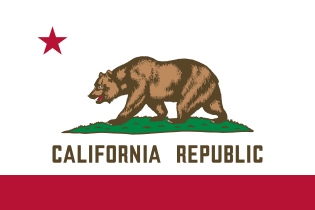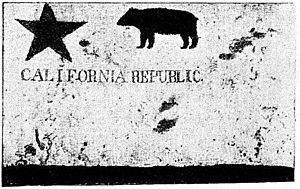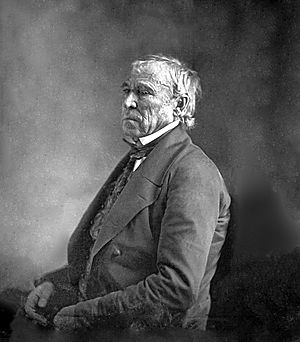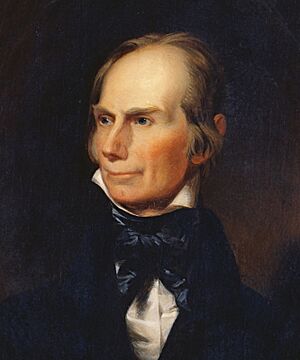An Act for the Admission of the State of California facts for kids
 |
|
| Other short titles | California Admissions Act |
|---|---|
| Long title | An Act for the Admission of the State of California into the Union |
| Enacted by | the 31st United States Congress |
| Effective | September 9, 1850 |
| Legislative history | |
|
|
The California Statehood Act was a special law passed by the United States government. It made California the 31st state to join the United States of America. California is unique because it became a state without first being a regular U.S. territory.
Contents
What is the California Statehood Act?
The official name of this important law is An Act for the Admission of the State of California into the Union. It was signed by President Millard Fillmore on September 9, 1850. This act officially made California the 31st state in the Union.
This law was part of a larger agreement called the Compromise of 1850. Under this compromise, California joined as a free state, meaning slavery was not allowed there. People often call this law the California Statehood Act or the California Admission Act.
Why Did California Become a State?
The Mexican-American War and Bear Flag Revolt
The United States declared war on Mexico on May 13, 1846. Soon after, American settlers in California started a rebellion against Mexican rule. This event, on June 15, 1846, was called the Bear Flag Revolt.
The settlers took over a small Mexican military post in Sonoma. They declared the California Republic, also known as the Bear Flag Republic. They raised their own Bear State flag. This republic only lasted 25 days. On July 9, 1846, the U.S. flag was raised, showing that California was now part of the United States.
The End of the War and Gold Rush
The Mexican–American War ended in 1848 with the signing of the Treaty of Guadalupe Hidalgo. In this treaty, Mexico gave a huge area of land, including California, to the United States. This new land was called the Mexican Cession.
At first, there was no rush to organize this new territory. But then, gold was discovered at Sutter's Mill in California! This started the California Gold Rush. Many people from America, Europe, and Asia rushed to California. They wanted to find gold or sell goods and services to the gold seekers. This sudden population boom meant California needed a proper government quickly. They needed laws for land, courts, police, and local services.
Debating California's Statehood
One big problem when new states joined the Union was whether they would allow slavery or not. This debate had been going on for a long time, even before the Missouri Compromise of 1820. California was a large territory with many natural resources and access to the Pacific Ocean. Its population was growing very fast. This made it urgent to decide its status.
Some people worried that if the U.S. didn't act fast, California might try to become an independent country. A big debate happened in Congress about California and the other lands from Mexico.
President Zachary Taylor became president in March 1849. He was from the South and owned enslaved people. However, he thought slavery wouldn't work well in the new territories. So, he was against expanding slavery there. This made it hard for Congress to agree on a solution.
In 1849, President Taylor told Congress that California's population was growing very fast. He said that the people of California had already met to create their own constitution and state government. He believed they would soon ask to join the Union as a state. He asked Congress to consider their request carefully.
California's constitution, which was finished on November 13, 1849, said that slavery was not allowed in the new state. President Taylor sent this proposal to Congress on February 13, 1850.
Then, President Taylor died unexpectedly on July 9, 1850. His Vice President, Millard Fillmore, became president. Fillmore was from the North, but he was more open to finding a compromise. This opened the door for the Compromise of 1850, which was put together by Henry Clay.
The compromise allowed California to join the Union without Congress forcing it to allow slavery. This was good for those who wanted California to be a free state. However, the compromise also included things that helped slave states. For example, slavery could possibly spread to other lands from Mexico. Also, the Fugitive Slave Act of 1850 was passed. This law made it harder for free states to protect Black people who were thought to be escaping slavery.
The Admission Act
Clay's Resolutions
On January 29, 1850, Senator Henry Clay suggested eight ideas to end the big debate about the new territories. These ideas were called the Clay Resolutions. They helped lead to the five laws that made up the Compromise of 1850. The first resolution was about California joining the Union. It said that California should be allowed to join as a state, without Congress telling it whether to allow or ban slavery.
What the Act Said
The California Admissions Act was the second law passed as part of the Compromise of 1850. It had three main parts and five key rules:
- It said that California was now a full and equal state in the Union (Section One).
- It gave California two representatives in the House of Representatives until the next population count (Section Two).
- It stated that public lands in California belonged to the federal government. California could not tax these lands (Section Three).
- It made sure that all waterways in California were open for anyone in the U.S. to use, without extra fees (Section Three).
- It declared that the act did not approve or reject any part of California's own constitution (Section Three).
The last rule in Section Three was important. It meant that Congress wasn't taking a side on California's decision to ban slavery in its constitution.
California Becomes a State
| California Admission Day | |
|---|---|

|
|
| Observed by | California, United States |
| Type | State Holiday |
| Date | September 9 |
California officially became the 31st state on September 9, 1850, when the Compromise of 1850 was signed. The United States House of Representatives approved the bill on September 7, 1850, with a vote of 150 to 56. The Senate had already voted to admit California on January 17, 1850, by a vote of 48 to 3. They agreed with the House vote on September 7, 1850.
California's first state legislature met on December 15, 1849, in San Jose. The first American governor of California was Peter Hardeman Burnett. He became governor on December 20, 1849, before California was officially a state.
California's first two U.S. Senators were John C. Frémont and William M. Gwin. They took their oaths of office on September 10, 1850. The state's first two Representatives, Edward Gilbert and George W. Wright, took their oaths on September 11, 1850.
California Admission Day
California Admission Day is a special holiday in California. It is celebrated every year on September 9. This day remembers when California joined the Union as the 31st state in 1850. The city of Monterey, California, where California's first constitution was written, celebrates this day as a city holiday. City offices and most facilities are closed.
See Also




